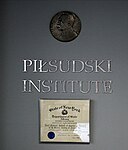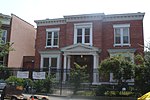Eberhard Faber Pencil Factory

The Eberhard Faber Pencil Factory is a former pencil factory complex in Greenpoint, Brooklyn, New York City. Designated as a historic district by the New York City Landmarks Preservation Commission (NYCLPC) in 2007, it is composed of nine buildings spread across two blocks. The factory was founded by John Eberhard Faber, the great-grandson of 18th-century pencil entrepreneur Kaspar Faber. The younger Faber established the United States' first pencil factory in Midtown Manhattan in 1866. Following a fire six years later, Faber moved to a larger location in Greenpoint, which expanded through the late 19th and early 20th centuries with the acquisition or addition of several buildings. Faber's children split the company from its German parent in 1898, and it remained in Greenpoint until 1956, when it moved to Pennsylvania. Today part of the complex is in use as the Kickstarter headquarters, while other portions of the complex have been converted to residential, commercial or industrial uses.
Excerpt from the Wikipedia article Eberhard Faber Pencil Factory (License: CC BY-SA 3.0, Authors, Images).Eberhard Faber Pencil Factory
Kent Street, New York Brooklyn
Geographical coordinates (GPS) Address Nearby Places Show on map
Geographical coordinates (GPS)
| Latitude | Longitude |
|---|---|
| N 40.730277777778 ° | E -73.958888888889 ° |
Address
Kent Street 62
11222 New York, Brooklyn
New York, United States
Open on Google Maps








